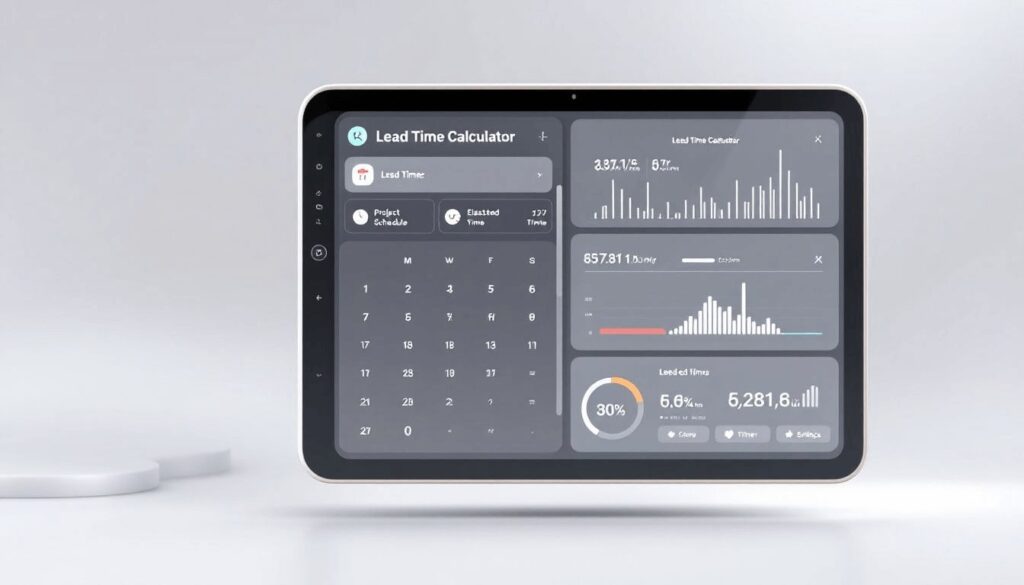Wondering how to measure the time it takes from placing an order to delivery? That’s where a lead time calculator comes in. In this guide, you’ll learn how to use a lead time calculator to improve efficiency, minimize delays, and keep your customers happy.
Key Takeaways
- Lead time is crucial for optimizing workflow efficiency and enhancing customer satisfaction in business processes.
- Understanding and categorizing different types of lead time—customer, material, production, and shipping—is essential for effective operational management.
- Implementing strategies such as supply chain optimization and process automation can significantly reduce lead times and improve overall project delivery.
Table of Contents
- Understanding Lead Time
- Types of Lead Time
- Lead Time vs. Cycle Time
- How to Calculate Lead Time
- Factors Influencing Lead Time
- Using Data to Drive Down Lead Times
- Strategies to Reduce Lead Time
- Tools for Lead Time Calculation
- Real-World Examples
- Summary
- Frequently Asked Questions
- Optimize Workflow Efficiency and Delight Your Customers with OIS Solutions
Understanding Lead Time

Lead time measures the period from the start of a process to its completion. Understanding lead time helps businesses enhance workflow efficiency and ensure timely project delivery. In a manufacturing context, lead time measures the period from when a customer places an order to when the product is delivered.
Average lead time is a key performance indicator in manufacturing and supply chain sectors, essential for scheduling, managing inventory, and identifying inefficiencies.
Insight into lead times improves customer communication about delivery schedules, boosting customer satisfaction and encouraging repeat orders by setting clear expectations. Optimizing lead time also relies on effective planning and strong supplier relationships.
Shorter lead times give companies a competitive edge by allowing quicker response to customer demands. Smaller order sizes streamline processing times, while better strategies improve lead times and overall efficiency, maximizing revenue.
Lead time is a crucial metric in various industries, including manufacturing, supply chain management, and project management. It refers to the total time required to complete a process or deliver a product from start to finish. Understanding lead time is essential for businesses to plan effectively, manage customer expectations, and optimize their operations.
Lead time is important because it directly impacts customer satisfaction, organizational profitability, and competitiveness. Accurate lead time calculation helps businesses to achieve their deliverables, reduce downtime and costs, and maximize productivity. It also enables companies to gain a competitive edge by offering faster lead times, which can lead to increased sales and revenue.
Types of Lead Time

Lead time encompasses the time needed for production, inventory management, order fulfillment, or shipping. It is categorized into customer lead time, material lead time, production lead time, and shipping lead time, each critical for various business operations.
Recognizing these lead time types is key to improving operational efficiency. Each presents unique challenges and optimization opportunities. Accurate calculations for each category streamline processes, reduce delays, and better meet customer expectations.
Customer lead time spans from order placement to product delivery, varying significantly with production approaches like make-to-order versus make-to-stock. In inventory management, it includes the time from placing an order to processing it upon receipt.
Managing customer lead time effectively helps meet customer expectations and enhances satisfaction, ensuring consistent demand fulfillment.
Material lead time begins when a need for materials is identified and ends upon receipt. It includes vendor processing, preparation, packing, and shipping times. In manufacturing, it covers the period from ordering raw materials to their arrival at the production facility.
Supplier reliability and geographic location significantly influence material lead time. Domestic suppliers often provide shorter lead times. Involving suppliers in demand forecasting ensures preparedness for order volume fluctuations, reducing potential delays.
Production lead time covers the period from placing a manufacturing order to when finished goods are ready for shipment, including material lead time, preprocessing, processing, and post-processing stages of the production processes. Analyzing lead times for sales and operational efficiency is essential, as it helps monitor both macro and micro KPIs to identify areas for improvement within these processes. Labor shortages can cause delays by idling jobs at critical times.
Production lead time stages range from material arrival to final product inspection before shipment. Efficient management of each stage is crucial for reducing overall lead time and ensuring timely delivery.
Shipping lead time spans from product readiness through handling and transit to final delivery, encapsulating logistics from manufacturing facility to customer. Factors like shipping method, distance, delivery lead time, and customs clearance significantly influence this period.
Storage time, the period inventory is held before shipping, also affects lead time. Efficient management of these stages minimizes shipping lead time, enhancing customer satisfaction and reducing supply chain lead time.
Lead Time vs. Cycle Time
Lead time and cycle time are two related but distinct concepts. Lead time refers to the total time required to complete a process or deliver a product, while cycle time refers to the time taken to complete a single cycle of the process. In other words, cycle time is a subset of lead time.
To illustrate the difference, consider a manufacturing process that involves producing a product from raw materials. The lead time would include the time required to procure raw materials, manufacture the product, and deliver it to the customer. The cycle time, on the other hand, would refer to the time taken to complete a single production cycle, such as the time required to assemble a product.
Understanding the difference between lead time and cycle time is essential for businesses to optimize their processes and improve their overall efficiency.

Avoid the Top 5 Mistakes Wholesale Distributors Make
Are you making one of the top 5 mistakes that plague wholesale distributors? Download our free eBook to find out. We’ve also included tips and guidance to help you save time and avoid costly mistakes.
How to Calculate Lead Time
Lead time, the total duration from the beginning of a process to its completion, is crucial for project managers as it impacts planning, scheduling, and resource allocation. Accurate lead time calculations prevent guesswork, boost efficiency, and enhance customer satisfaction.
Lead time calculations include production time, processing time, and transportation time. Adding buffer time for unforeseen delays is vital in these calculations.
Reviewing actual performance data enhances the accuracy of lead time calculations, helping teams avoid overproduction or underproduction.
The formula for calculating lead time is straightforward: Lead Time = Order Delivery Date – Order Request Date, or alternatively, Lead Time = Time of completion – Start time. This basic formula provides a clear way to calculate the total time from order placement to delivery.
Order processing lead time includes all tasks required to prepare an order for delivery, such as picking and packing. Analyzing historical data aids in accurate lead time calculations and future projections.
Safety stock acts as a buffer against demand and supply uncertainty, keeping inventory levels stable during fluctuations. Calculating safety stock typically involves assessing demand variability and lead time, considering factors like customer demand variability, supplier reliability, and the desired service level.
Effectively applying the safety stock formula minimizes stockouts and maintains customer satisfaction. Proper safety stock management is crucial for efficient inventory management and consistent customer service.
The reorder point is the inventory level at which new stock should be ordered to avoid stockouts. Identifying this point helps businesses know when to order more stock, preventing runouts. For instance, a supplier might take three days to start on a fabric reorder, illustrating a reordering delay.
Accurately determining the reorder point maintains inventory levels, prevents supply chain disruptions, and ensures efficient inventory management.

Several factors, both internal and external, influence lead time. Internal factors like production efficiency and workforce management are crucial. A well-structured production process can reduce overall lead time by speeding up manufacturing times.
Significant human errors can independently increase manufacturing lead time. Supplier reliability also impacts lead time, especially when relying on external suppliers for raw materials. Transportation logistics—like traffic conditions and weather—are vital external factors affecting lead times.
Market demand fluctuations can overload production facilities, extending lead times due to increased pressure. Holding safety stock mitigates risks from supply delay and ensures timely production. Managing these factors effectively is essential for efficient operations and reducing total lead time.
Using Data to Drive Down Lead Times
Data plays a critical role in driving down lead times. By analyzing data on lead times, businesses can identify bottlenecks, optimize their processes, and make informed decisions. Here are some ways to use data to drive down lead times:
Track lead times: Monitor lead times for different products, processes, and suppliers to identify areas for improvement.
Analyze production data: Analyze production data to identify bottlenecks, optimize production schedules, and reduce waste.
Use lead time formulas: Use lead time formulas, such as the manufacturing lead time formula, to calculate lead times and identify areas for improvement.
Monitor supply chain data: Monitor supply chain data to identify delays, optimize inventory levels, and reduce supply chain lead times.
Use data visualization tools: Use data visualization tools to visualize lead time data and identify trends and patterns.
By using data to drive down lead times, businesses can improve their efficiency, reduce costs, and enhance customer satisfaction.
Strategies to Reduce Lead Time

Reducing lead time is a strategic goal for many businesses, achievable through various methods. Eliminating unnecessary manufacturing processes and automating tasks are effective ways to decrease manufacturing lead time.
Identifying and eliminating potential delays helps remove roadblocks that hinder lead time. Streamlining the supply chain and managing supplier relationships further reduce lead times. Calculating lead time for each process step minimizes unplanned downtime and overall costs.
Optimizing the entire supply chain management reveals areas for lead time reduction. Increasing process automation addresses labor shortages in manufacturing. Tools like ProjectManager track lead time and identify inefficiencies, aiding better management.
Real-time dashboards capture and display live data on graphs for easy understanding, providing a high-level production view and enabling quick anomaly detection. These dashboards require no setup and are ready to use immediately.
Managing supplier relationships ensures timely delivery and prevents increased lead times. Strong relationships allow order prioritization, reducing delays. Establishing lead time contracts clarifies delivery expectations, mitigating delays.
Regular communication with suppliers strengthens relationships and improves lead time management. Eliminating unreliable suppliers enhances lead time consistency. Auditing and consolidating vendors reduce lead time variability.
Automation significantly reduces lead times for individual processes and the overall workflow. Examples include setting notifications for overdue tasks and automatically assigning completed tasks. Automated workflows eliminate unnecessary human involvement and streamline operations.
Automating workflows in project management streamlines processes and enhances efficiency. Automating order entry minimizes errors and improves tracking metrics, resulting in more accurate lead time predictions.
Tools for Lead Time Calculation

Tools and software accurately calculate and manage lead time, impacting project efficiency and resource allocation. ProjectManager, for instance, offers Gantt charts, dashboards, reports, and resource management to effectively handle lead time.
ClickUp provides all-in-one project management software with task tracking and performance measurement for lead times. Robust inventory management software effectively manages stock levels, assisting in lead time calculation.Kanban boards visually represent tasks and their progress, aiding in lead time identification. They allow users to see task status at a glance, making workflow management easier. Teams can quickly identify bottlenecks and make swift adjustments using Kanban boards.
The clear visual representation on Kanban boards helps teams manage lead time effectively. This tool is especially useful for project managers aiming to optimize processes and improve efficiency.
Project management tools provide insights into production times to minimize lead times. Such software plays a critical role in efficiently managing and tracking lead times. Real-time data and analytics enable teams to make informed decisions, enhancing lead time efficiency.
These tools help project managers streamline workflows, improve resource allocation, and ensure timely project delivery, leading to better overall project performance and customer satisfaction.
Real-World Examples
Real-world examples illustrate the practical applications of lead time calculations, making the concept easier to grasp. For instance, SaaS tools often have an instant customer lead time, delivered immediately upon order, highlighting the importance of quick service delivery and customer satisfaction across various industries.
Such examples demonstrate how lead time varies and impacts different markets. Understanding these scenarios helps businesses appreciate accurate lead time calculations and optimize their processes.
Summary
In summary, mastering lead time calculation is essential for enhancing workflow efficiency, ensuring timely project delivery, and boosting customer satisfaction. By understanding the different types of lead time and the factors influencing them, businesses can implement effective strategies to reduce lead times. Utilizing tools like Kanban boards and project management software can further streamline processes and improve accuracy.
As you strive to optimize your lead times, remember that every improvement, no matter how small, contributes to greater operational efficiency and customer satisfaction. Embrace the strategies and tools discussed in this guide to transform your business processes and stay ahead of the competition.
Frequently Asked Questions
Lead time refers to the total duration from the initiation of a process to its completion, making it essential for effective planning and management. Understanding lead time allows for better resource allocation and timeline forecasting.
To calculate lead time, use the formula: Lead Time = Order Delivery Date – Order Request Date, or alternatively, Lead Time = Completion Time – Start Time. This provides a clear timeframe for your order or project.
Lead time is influenced by factors such as production efficiency, workforce management, supplier reliability, transportation logistics, and fluctuations in market demand. Understanding these elements can help streamline processes and reduce delays.
To effectively reduce lead time, businesses should focus on eliminating unnecessary processes, automating tasks, optimizing the supply chain, and strengthening supplier relationships. Implementing these strategies can lead to significant improvements in efficiency.
Using tools such as ProjectManager, ClickUp, and Kanban boards can significantly enhance the management and calculation of lead time, ensuring more efficient project workflows.
Optimize Workflow Efficiency and Delight Your Customers with OIS Solutions
Lead time optimization is key to enhancing operational efficiency and meeting customer expectations. OIS Solutions empower wholesale distributors and manufacturers to streamline workflows with advanced tools like real-time inventory tracking, seamless order management, and on-the-go invoicing. Reduce delays, improve accuracy, and deliver exceptional service every time.
Experience the power of optimized operations with OIS today.






